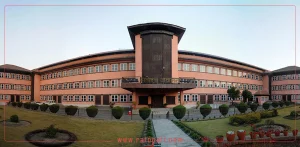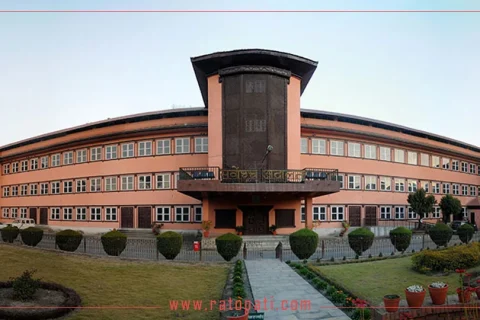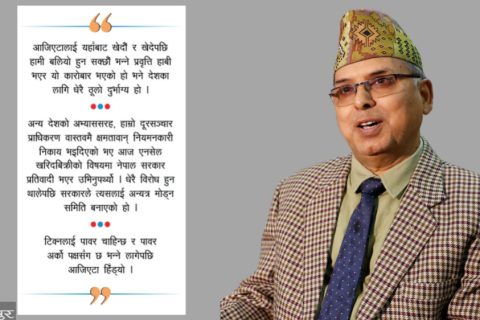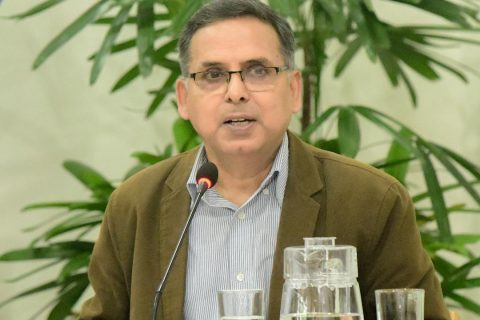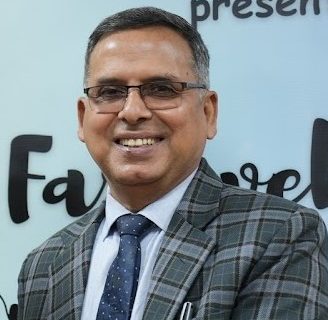As lawyers pleading on behalf of petitioners challenging Prime Minister KP Sharma Oli’s House dissolution move continued to parse constitutional provisions, advocate Dinmani Pokhrel brought up one of Subas Nembang’s interviews in which the two-time Constituent Assembly chair said the current constitution does not allow a prime minister to dissolve Parliament.
Pokhrel presented before the court a magazine, titled Smarika, published by the federal parliament annually, in which the interview was published.
“We have accepted the existing parliamentary system as an improved parliamentary system. For instance, a no-confidence motion against the prime minister cannot be brought for two years, and once it is tabled another motion cannot be presented for another year,” Nembang has said in the interview. “On the basis of our past experience, we have included new provisions including the one that says the prime minister cannot dissolve Parliament.”
Nembang was explaining the major highlights of the new constitution in the interview published last year.
Lawyers on Monday also talked about a video clip that had recently gone viral, in which Nembang says the constitution does not allow the prime minister to dissolve the House.
In the video clip, posted on Twitter from the handle @jspanepal, which in its bio says “official twitter account of Journalists’ Society for Parliamentary Affairs”, Nembang is heard explaining why the provision of not allowing a prime minister to dissolve Parliament on a whim was inserted in the constitution.
“[In the past] whenever a prime minister was angry with lawmakers, he used to dissolve the Parliament. We removed that [provision] and now the prime minister cannot dissolve as we have excluded that provision,” Nembang is heard saying while speaking at a function organised by the Parliament Secretariat at Dhulikhel in July 2019.
“I made a plea before the justices to take them as persuasive evidence to know the intent of the drafters,” advocate Saroj Krishna Ghimire, the other lawyer to take part in the hearing on Monday, told the Post.
But Chief Justice Cholendra Shumsher Rana and Justice Sapana Malla Pradhan questioned whether such videos could be taken into consideration in court.
The Oli government has cited Articles 76 (1), 76 (7) and 85 for dissolving the House.
Chief Justice Rana has been constantly asking, at almost every hearing, why a prime minister cannot say he does not want to govern and seek a fresh mandate of the people.
But lawyers have argued that Articles 76 (1) and 76 (7) talk about the formation of a government, and since the issue is of House dissolution, the bench should look to legislative intent.
Legislative intent is defined as “the ends sought to be achieved by a legislature in an enactment.” Courts often look to legislative intent for guidance in interpreting and applying a law.
The drafters of the Constitution of Nepal 2015 say that taking the bad experience of political instability–frequent change of governments and prime minister dissolving the House at the drop of a hat–into account, they had debated at length before writing Article 76 (1) to Article 76 (7) so as to ensure that a prime minister has to fulfil various conditions for dissolving the House.
The drafters had also inserted a provision, which is not seen in any country practicing parliamentary democracy, that said a no-confidence motion cannot be moved against the prime minister for two years.
Article 100 (4) of the constitution states that a motion of no confidence shall not be tabled until the first two years after the appointment of the prime minister and until another year after the date of failure of such a motion.
Though what the lawyers presented before the five-member Constitutional Bench led by Chief Justice Rana are unlikely to be taken as evidence, experts say their attempt to request the bench to look to legislative intent is not wrong.
Balaram KC, a former Supreme Court justice, said the video clip and interview of Nembang are not accepted as evidence before the court of law but the question of legislative intent is justified.
“As some lawyers have demanded, transcripts of the debate during the constitution drafting process, [Constituent Assembly] committee notes and other records can be presented before the court as admissible evidence,” KC told the Post. “Such documents and records are intrinsic to the process and help in interpretation of the constitutional provisions.”
Though experts on constitutional matters have argued for long that the present constitution, prima facie, does not allow a majority prime minister to dissolve the House, Oli and those defending him have been presenting a different interpretation of constitutional provisions.
At Sunday’s hearing, when advocate Bhimarjun Acharya argued that the present constitution strictly bars the prime minister from dissolving the House, Chief Justice Rana had questioned: “Isn’t it the prime minister who dissolves the House as per Article 76 (7)?”
Experts on constitutional and legal matters say the constitutional provisions need to be followed both in letter and spirit.
When letters and words create ambiguity, interpreters should explore in what spirit they were written. That’s where legislative intent comes, according to the experts.
“In the current context, we should better call it the Constituent Assembly’s intent rather than legislative intent,” said senior advocate Chandra Kanta Gyawali, an expert on constitutional affairs. “Documents and transcripts of the constitution drafting process can help in understanding the intention of the drafters when they wrote those articles barring the prime minister from dissolving the House.”
Since 1990, four prime ministers have attempted House dissolution.
But all those attempts were made under the Constitution of Nepal 1990, which had vested in the prime minister the prerogative to dissolve the Parliament under Article 53 (4).
“The drafters of this constitution decided not to have any provision like the one in the 1990 constitution giving the prime minister the authority to dissolve the House at his will,” said KC. “The intent behind that was such a provision was doing more harm than good.”
However, there is a sizable number of experts who argue that a constitution not allowing the prime minister to dissolve the House is flawed because in the parliamentary system of democracy, the prime minister has an inherent power to dissolve the House.
Bipin Adhikari, a former dean of Kathmandu University School of Law, said since the current constitution has already robbed the prime minister of what is called his/her inherent power in the parliamentary democracy to dissolve the House, there is no problem in the current provisions and they are very clear.
“It was a well-thought-out decision to end instability,” said Adhikari. “The life of the House of Representatives is until when it is ended by effluxion of time five years from its first meeting. If that were to be changed, there must be an enabling provision, [and] that’s not in our constitution.”
According to Adhikari, despite clear provisions in the constitution, if there is any confusion–which actually should not be–the court could look to the intent of the Constituent Assembly by examining the transcripts, records and notes of the drafting process.
“Not allowing a prime minister to dissolve the House was a planned departure,” said Adhikari. “With no provisions in the constitution allowing the prime minister to end the life of the House, those who are defending the move are calling it a political decision.”


